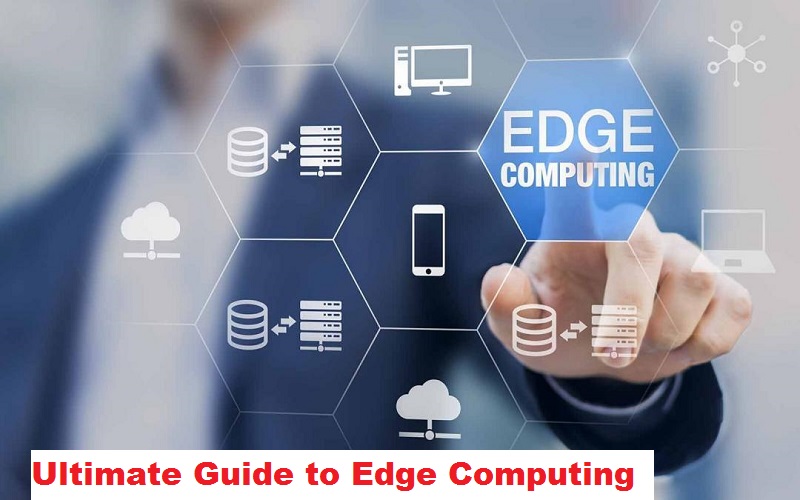 Infographics for Backlinks – Visual Goldmines for Authority Sites!
Infographics for Backlinks – Visual Goldmines for Authority Sites!
Ultimate Guide to Edge Computing - You Should be Known
Written by DigitalThinkerHelp » Updated on: June 17th, 2025

Edge computing refers to a distributed computing paradigm that brings data processing and computation closer to the source of data generation, rather than relying on a centralized cloud infrastructure. In edge computing, data processing occurs at or near the edge of the network, typically within or near the devices or sensors that generate the data. This approach aims to reduce latency, enhance real-time responsiveness, and alleviate the burden on the network infrastructure.
Traditionally, with cloud computing, data is sent from edge devices to remote data centers or servers for processing and analysis. However, edge computing enables localized processing, allowing data to be analyzed and acted upon in real time, closer to where it is generated. This is particularly beneficial for applications that require low latency, such as Internet of Things (IoT) devices, autonomous vehicles, industrial automation, and smart cities.
Different Types of Edge Computing
There are different types of edge computing, each with its own characteristics and applications. Here are some notable types:
Fog Computing: Fog computing extends the cloud computing paradigm to the edge of the network, enabling data processing and analysis at local devices or edge servers. It aims to overcome the limitations of cloud-centric architectures by distributing computational resources closer to the data source. Fog computing is particularly useful in scenarios with large numbers of IoT devices and low-latency requirements.
Mobile Edge Computing (MEC): MEC, also known as Multi-access Edge Computing, brings computing resources and services to the cellular network's edge. By leveraging the base station infrastructure, MEC enables low-latency and high-bandwidth applications, such as augmented reality (AR), virtual reality (VR), and real-time video processing. MEC enhances user experience, reduces backhaul traffic, and enables new edge-based services.
Cloudlet: A cloudlet is a small-scale data center deployed at the edge of a network. It acts as an intermediary between end devices and the cloud, providing computational resources and services closer to the user. Cloudlets are typically used in mobile and wireless computing environments to reduce latency, support resource-intensive applications, and provide better QoS (Quality of Service).
Edge Data Centers: Edge data centers are smaller-scale data centers located closer to the end users or data sources they serve. They bring processing power and storage capabilities closer to the edge, enabling faster data analysis and reducing latency. Edge data centers are commonly deployed in industries such as healthcare, manufacturing, transportation, and smart cities.
Edge AI: Edge AI refers to the deployment of artificial intelligence (AI) algorithms and models on edge devices or edge servers. By performing AI computations locally, edge AI enables real-time inference and decision-making, while minimizing the dependency on cloud connectivity. Edge AI is used in various applications, including autonomous vehicles, smart cameras, robotics, and industrial automation.
Edge Cloud: An edge cloud is a distributed cloud computing infrastructure that extends cloud services and resources to the edge of the network. It combines the benefits of cloud computing with low-latency edge processing. Edge clouds are often deployed in locations such as data centers, telecom towers, and central offices, enabling faster data processing and reducing the need to backhaul data to distant cloud data centers.
Edge-as-a-Service (EaaS): Edge-as-a-Service is a model where edge computing resources and services are offered to users on a pay-per-use basis. It allows organizations to access and utilize edge computing infrastructure without having to invest in their own hardware and infrastructure. EaaS providers manage the underlying edge infrastructure and offer services such as edge analytics, security, and application deployment.
Edge Networking: Edge networking refers to the use of networking technologies and protocols that enable efficient data communication and connectivity at the network edge. It focuses on optimizing network performance, reducing latency, and improving bandwidth utilization. Edge networking is crucial for applications that require real-time data transfer, such as video streaming, online gaming, and teleconferencing.
Edge Security: Edge security involves implementing security measures and protocols at the edge of the network to protect devices, data, and applications. By enforcing security mechanisms closer to the data source, edge security helps mitigate risks associated with data transmission and centralized data centers. It includes techniques such as encryption, access control, anomaly detection, and real-time threat intelligence.
Edge Storage: Edge storage involves storing and managing data at the edge of the network, typically on local storage devices or edge servers. It enables quick access to data for local processing and reduces the dependency on cloud storage. Edge storage is beneficial for applications that generate large volumes of data, such as video surveillance, IoT sensor networks, and autonomous vehicles.
Edge Analytics: Edge analytics refers to the process of analyzing data locally at the edge devices or edge servers, rather than sending it to a centralized location. By performing analytics at the edge, organizations can extract real-time insights, reduce bandwidth requirements, and make faster decisions based on localized data. Edge analytics is particularly valuable in time-sensitive applications, such as predictive maintenance, anomaly detection, and real-time monitoring.
Components of Edge Computing
It consists of several key components that work together to enable efficient and decentralized computing at the edge of the network. Here are the main components of edge computing:
Edge Devices: These are physical devices located at the edge of the network, such as sensors, cameras, IoT devices, gateways, and edge servers. These devices collect and generate data from their surroundings or connected systems.
Edge Nodes: Edge nodes are computing devices or servers that are responsible for processing and analyzing data at the edge. They are more powerful than edge devices and can perform complex tasks, such as data filtering, aggregation, preprocessing, and local analytics.
Edge Gateway: An edge gateway acts as an intermediary between edge devices and the central cloud or data center. It helps in aggregating and transmitting data from multiple edge devices to the cloud or data center, often performing data filtering and protocol translation.
Edge Analytics: Edge analytics refers to the capability of performing data analysis and processing at the edge of the network. This allows for real-time insights and immediate actions based on the processed data, without the need to send all data to the cloud. Edge analytics can be performed on edge nodes or specialized hardware accelerators.
Edge Infrastructure: The edge infrastructure includes the physical and virtual resources required to support edge computing. It consists of edge servers, network equipment, storage devices, and software frameworks that enable the deployment, management, and orchestration of edge computing resources.
Edge Software: Edge software refers to the collection of software components that run on edge devices and nodes. It includes operating systems, middleware, edge management software, security modules, and application-specific software. These software components facilitate data processing, communication, and security at the edge.
Edge Connectivity: Edge computing relies on robust and low-latency connectivity between edge devices, nodes, and the central cloud or data center. Various connectivity technologies such as Wi-Fi, Bluetooth, cellular networks, and dedicated high-speed links are used to establish communication between edge components.
Edge Security: Security is a crucial component of edge computing, given the distributed nature of edge devices and the potential exposure to cyber threats. Edge security includes authentication mechanisms, encryption, access control, secure communication protocols, and security monitoring systems to ensure data integrity and protect against unauthorized access or attacks.
These components work together to create an edge computing ecosystem that enables efficient and localized data processing, real-time analytics, reduced network congestion, improved scalability, and enhanced privacy and security.
Edge Computing Applications
Here are some applications of edge computing:
Internet of Things (IoT): Edge computing plays a vital role in IoT deployments. By processing and analyzing data at the edge, IoT devices can quickly respond to local events, reducing latency and dependence on cloud infrastructure. It enables real-time monitoring, control, and decision-making in various domains such as smart homes, industrial automation, healthcare, and transportation.
Smart Cities: Edge computing is instrumental in developing smart city infrastructure. It enables efficient management of resources like traffic control, waste management, energy distribution, and public safety. Edge devices placed throughout the city can collect and analyze data in real-time, facilitating quicker responses to changing conditions and enhancing overall operational efficiency.
Video Surveillance: Edge computing is widely used in video surveillance systems. Rather than sending video feeds to a central server for processing, edge devices equipped with video analytics capabilities can analyze the footage locally. This reduces network congestion, improves real-time monitoring, and enables faster detection of security threats.
Content Delivery: Edge computing enhances content delivery networks (CDNs) by bringing content closer to end-users. By caching and processing content at edge locations, the delivery time is reduced, resulting in faster loading times for websites, videos, and other media. This approach minimizes latency and improves user experience.
Autonomous Vehicles: Edge computing is crucial for the development of autonomous vehicles. These vehicles generate a massive amount of data that needs to be processed quickly to make real-time decisions. Edge devices in the vehicles or at the roadside infrastructure can perform local data processing, enabling faster response times, improved safety, and reduced reliance on cloud connectivity.
Healthcare: Edge computing has significant applications in healthcare. It allows for real-time analysis of patient data, enabling remote monitoring, early detection of abnormalities, and timely interventions. Edge devices can also support wearable health trackers, monitoring vital signs and alerting healthcare professionals in case of emergencies.
Retail: Edge computing is utilized in the retail sector for various applications. It enables personalized marketing by capturing and analyzing customer data in real-time. It also facilitates inventory management, ensuring accurate stock levels and minimizing out-of-stock situations. Additionally, edge devices can power in-store experiences such as interactive displays and smart shelves.
Energy Management: Edge computing can optimize energy management systems. By collecting and analyzing data from smart meters, sensors, and other energy monitoring devices, it enables real-time monitoring, load balancing, and predictive maintenance. This leads to more efficient energy usage, reduced costs, and improved sustainability.
Industrial Automation: Edge computing is extensively used in industrial automation and control systems. It allows for real-time data processing and analysis at the edge, enabling faster response times and improved operational efficiency. Edge devices can collect sensor data, perform analytics, and control actuators locally, reducing the dependence on centralized control systems and minimizing latency.
Natural Disaster Management: Edge computing can play a vital role in natural disaster management and emergency response systems. By deploying edge devices in disaster-prone areas, data can be collected and analyzed locally, enabling faster detection of events such as earthquakes, floods, or fires. This facilitates quicker response times, helps in decision-making, and improves disaster recovery efforts.
Agriculture: Edge computing has applications in precision agriculture, where it enables real-time monitoring and control of farming operations. By deploying edge devices in fields, data on soil conditions, weather patterns, and crop health can be collected and analyzed locally. This information can be used to optimize irrigation, pest control, and fertilizer application, leading to improved yields and resource efficiency.
Gaming: Edge computing has the potential to enhance the gaming experience by reducing latency and enabling real-time interactions. By processing game logic and rendering graphics at the edge, players can experience faster response times and smoother gameplay. Edge servers can also enable multiplayer gaming by facilitating efficient communication and synchronization between players.
Financial Services: Edge computing can be utilized in the financial services sector for various applications. It can enable faster and more secure transaction processing by performing local verification and validation at the edge. It can also support real-time fraud detection and prevention by analyzing transaction data in real-time, minimizing the risk of unauthorized activities.
Remote Environments: Edge computing finds applications in remote and challenging environments where reliable network connectivity may be limited. For example, in offshore oil rigs, mining operations, or remote research stations, edge devices can process and analyze data locally, reducing dependence on cloud connectivity and enabling real-time monitoring and control.
Augmented Reality/Virtual Reality (AR/VR): Edge computing can enhance AR/VR experiences by offloading resource-intensive tasks to edge devices. By processing and rendering AR/VR content at the edge, it reduces latency, enables real-time interactions, and improves the overall user experience.
What are the Advantages and Disadvantages of Edge Computing?
While edge computing offers several advantages, it also comes with certain disadvantages. Let's explore both aspects:
Advantages of Edge Computing:
Reduced latency: By processing data locally at the edge devices or edge servers, edge computing significantly reduces the latency involved in transmitting data to a remote cloud server. This is particularly beneficial for time-sensitive applications such as real-time analytics, autonomous vehicles, or industrial automation, where low latency is crucial.
Enhanced performance: Edge computing allows for faster data processing and real-time decision-making, as data is processed locally rather than being transmitted to a remote server. This is advantageous for applications that require immediate responses or actions, improving overall system performance and user experience.
Bandwidth optimization: By processing and filtering data at the edge, only relevant or condensed information needs to be transmitted to the central cloud infrastructure. This reduces the volume of data sent over the network, optimizing bandwidth usage and lowering costs associated with data transmission.
Improved security and privacy: Edge computing can enhance security and privacy by keeping sensitive data localized rather than transmitting it to external cloud servers. This can be especially beneficial in sectors like healthcare or finance, where data privacy regulations are stringent, or in scenarios where maintaining data sovereignty is important.
Offline operations: Edge computing enables devices and systems to continue functioning even when the network connection is disrupted or unreliable. By performing computations and making decisions locally, edge devices can operate independently, ensuring business continuity and reducing dependency on constant connectivity.
Disadvantages of Edge Computing:
Limited processing capabilities: Edge devices, such as IoT sensors or small-scale edge servers, often have limited processing power, memory, and storage capacity compared to centralized cloud servers. This constraint can restrict the complexity and scale of applications that can be run at the edge, requiring trade-offs in terms of functionality and computational requirements.
Management complexity: With edge computing, the distributed nature of infrastructure introduces complexity in managing a large number of edge devices or edge servers. Deploying, monitoring, updating, and maintaining software and configurations across a distributed edge environment can be challenging and resource-intensive.
Data synchronization and consistency: When data processing and storage are distributed across multiple edge devices, ensuring data synchronization and consistency can become more complex. Coordinating data across the edge and central cloud infrastructure to maintain a coherent view of the system can be challenging, requiring additional mechanisms and protocols.
Cost considerations: While edge computing can reduce bandwidth costs by minimizing data transmission, it may incur additional costs in terms of deploying and maintaining edge infrastructure. Organizations need to evaluate the cost-benefit trade-off between local processing capabilities and the scale of centralized cloud infrastructure.
Scalability limitations: Scaling edge computing deployments to handle increasing data volumes or user demands can be challenging. Adding new edge devices or expanding edge infrastructure requires careful planning and coordination to ensure efficient resource allocation and system scalability.
Note: IndiBlogHub features both user-submitted and editorial content. We do not verify third-party contributions. Read our Disclaimer and Privacy Policyfor details.
Men's Journal is a rugged and refined lifestyle adventure travel, food and drink Get in touch [email protected] to find out how we can help you reach everyday, affluent, and adventure seeking consumers on Men's Journal
Copyright © 2019-2025 IndiBlogHub.com. All rights reserved. Hosted on DigitalOcean for fast, reliable performance.












